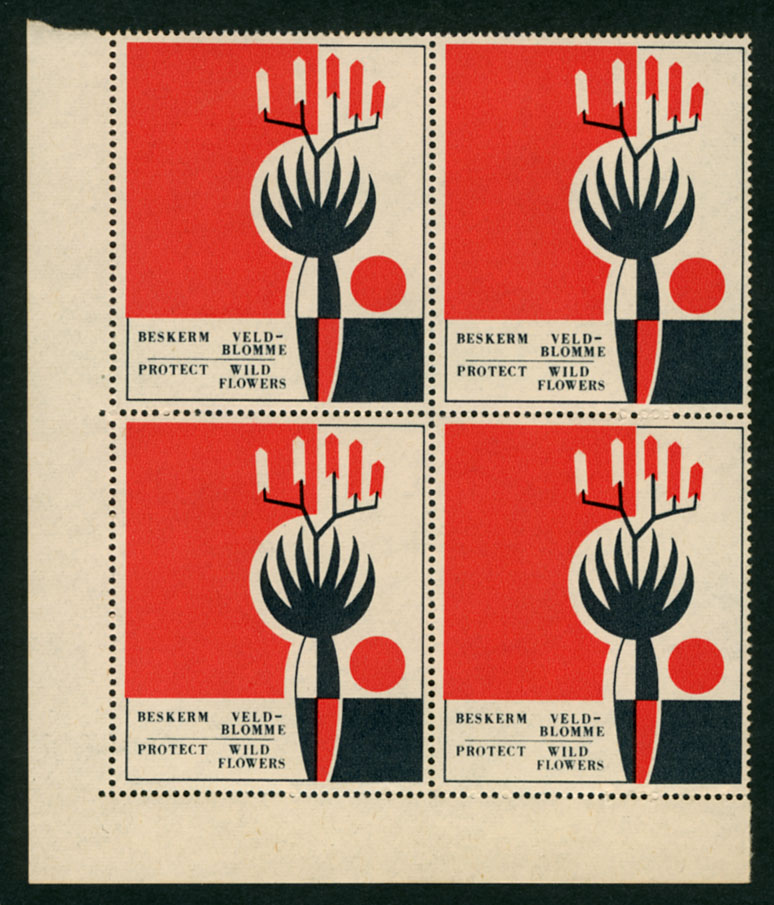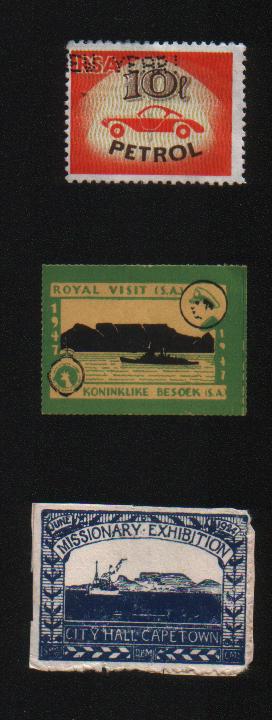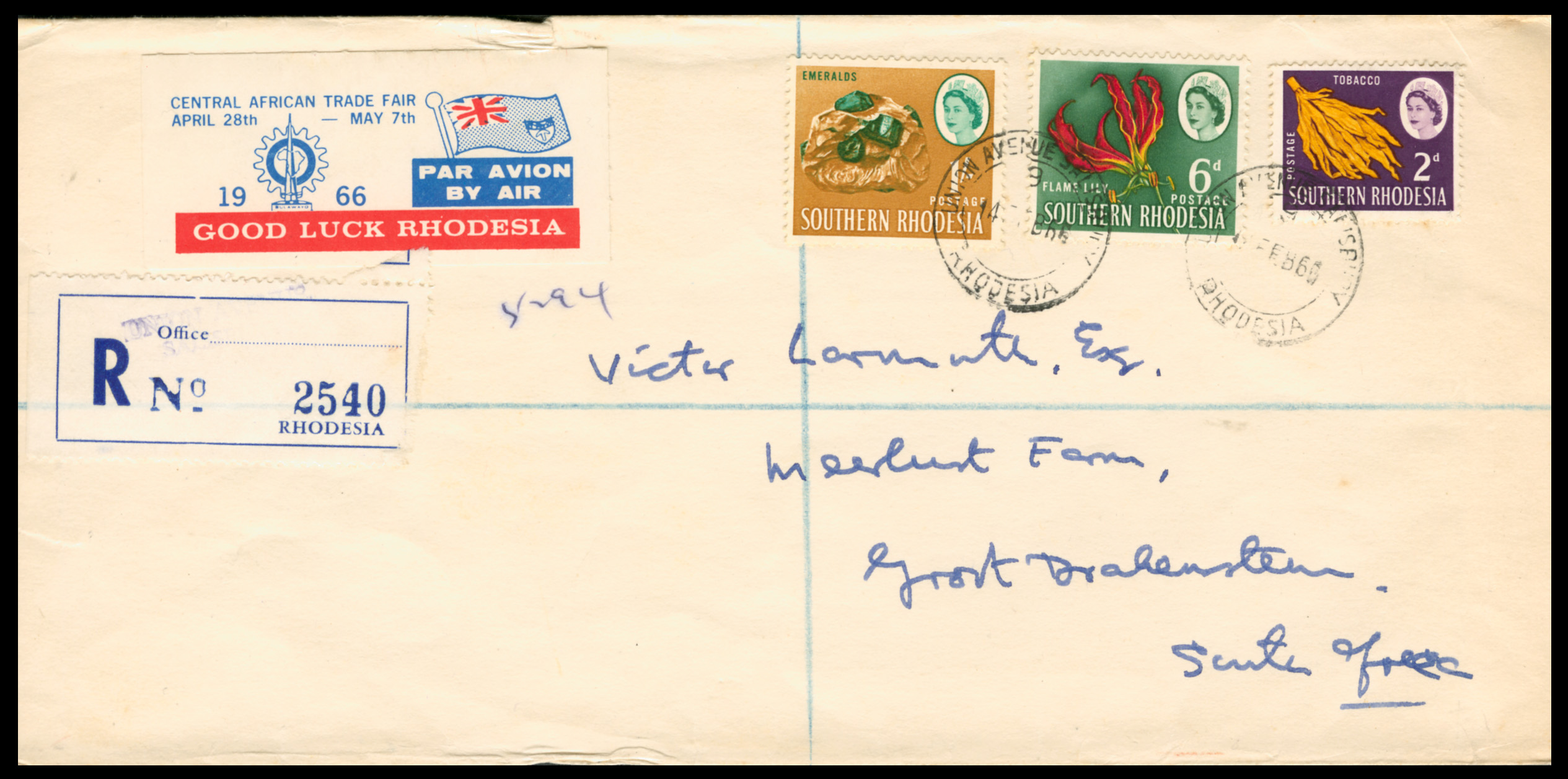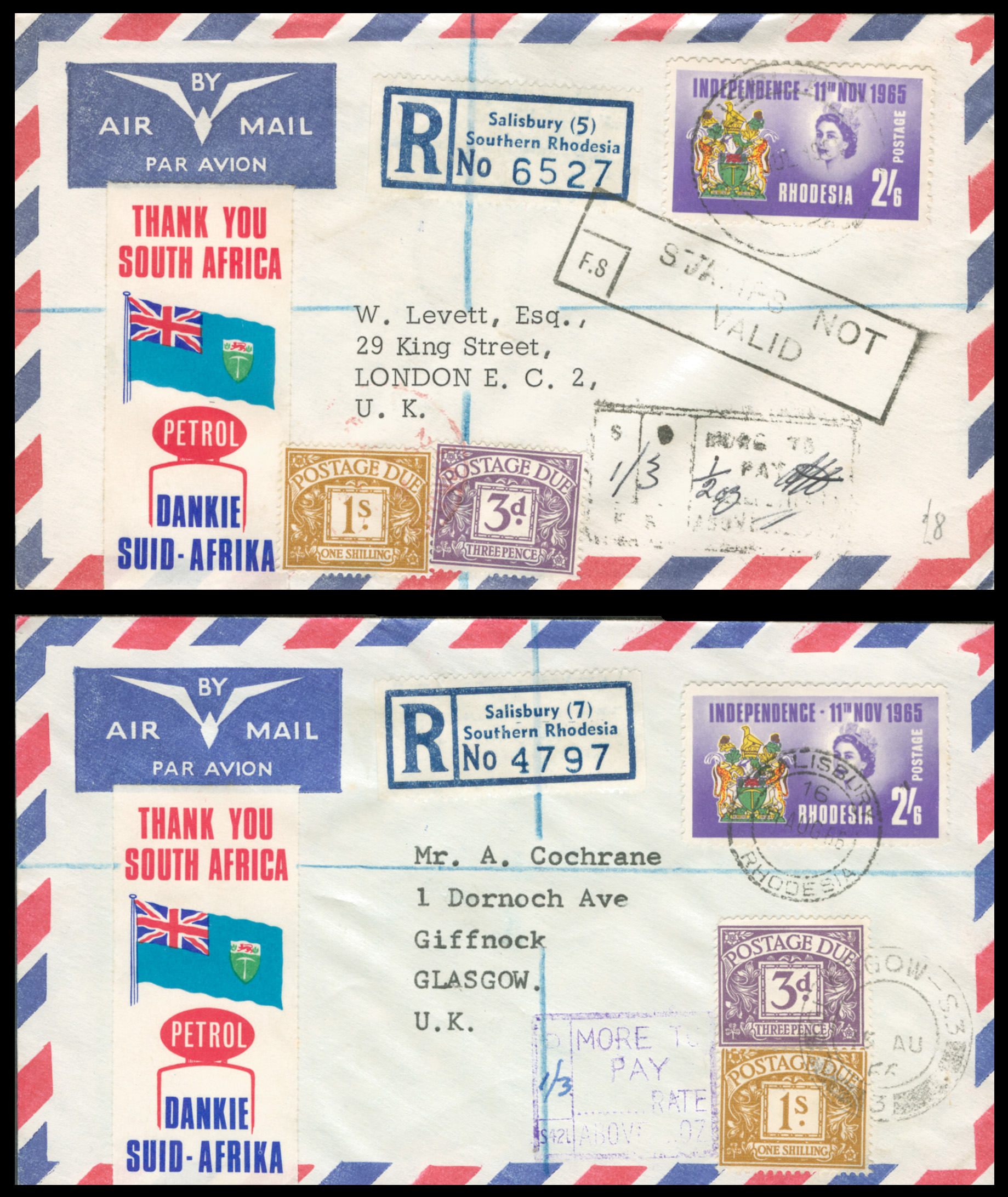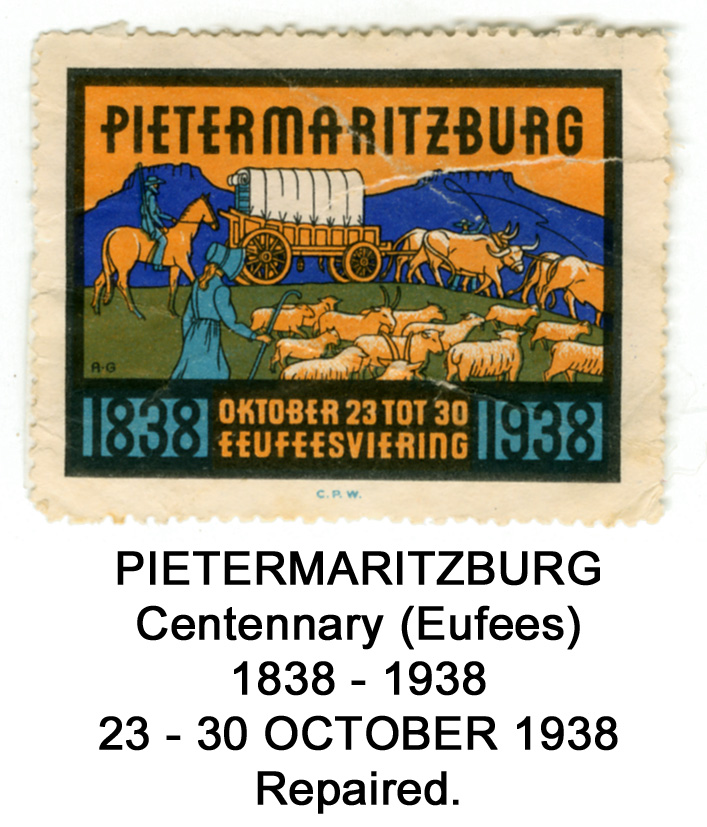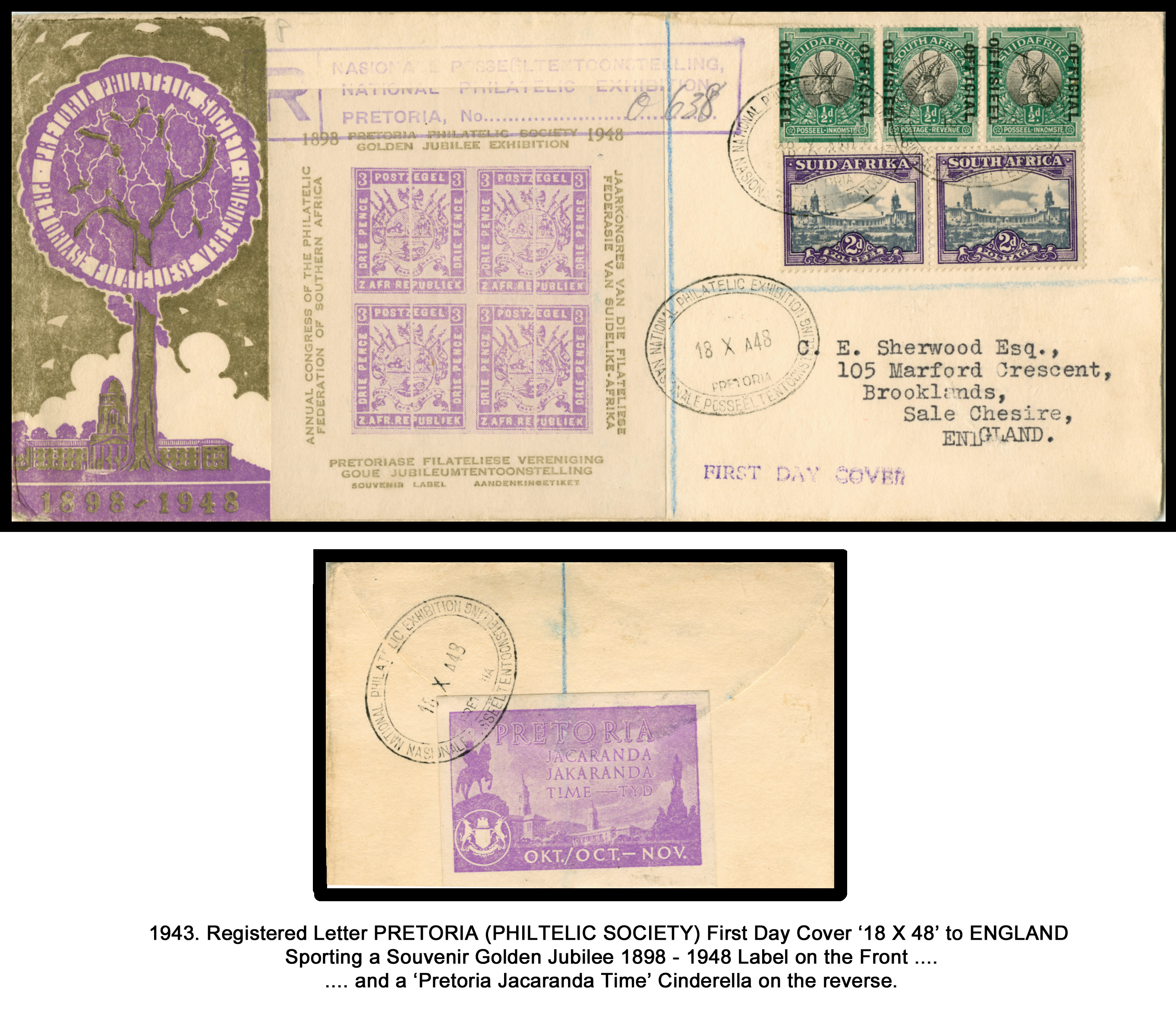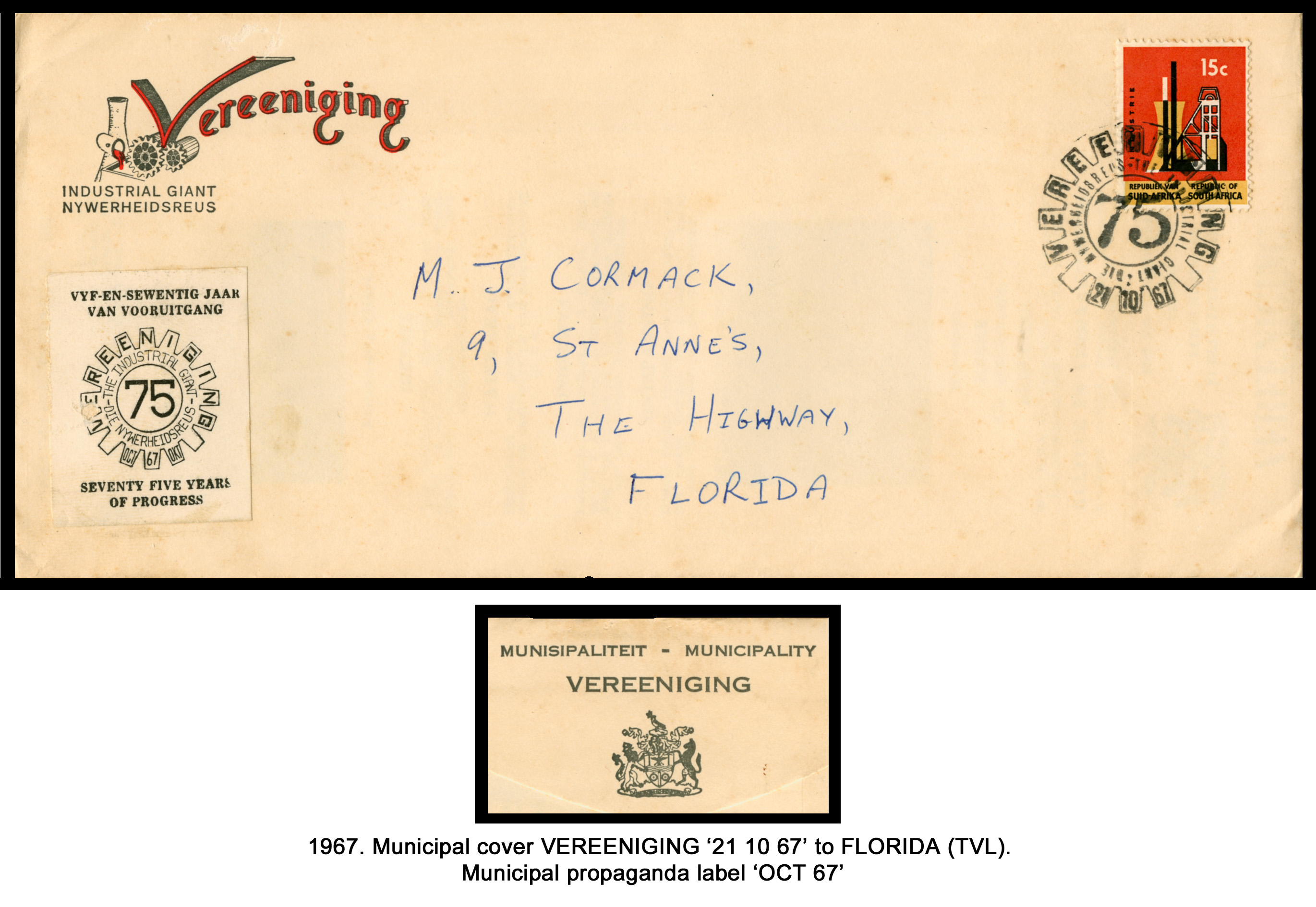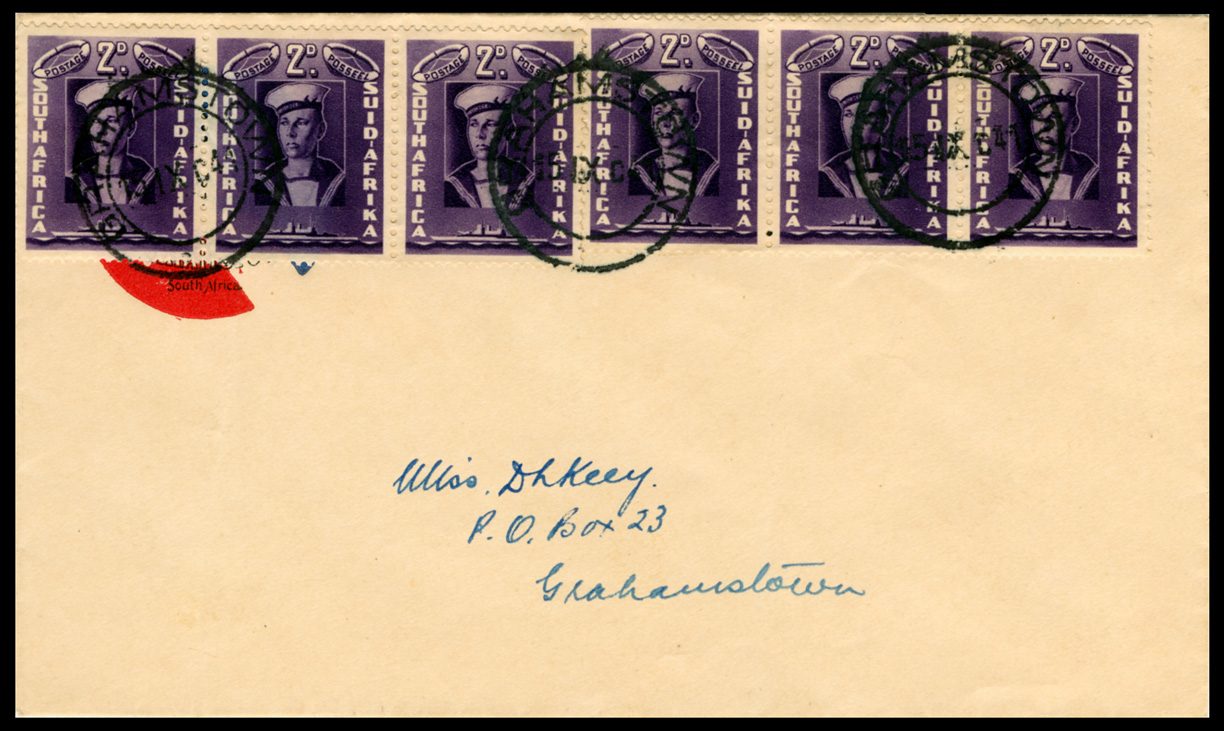South African Cinderellas (labels).
Quote from Jamie Smith on January 11, 2022, 7:16 amRecent off Chris Rainey. Don't remember where the stamp came from.
Recent off Chris Rainey. Don't remember where the stamp came from.
Quote from Steve on March 6, 2023, 11:10 amAt a SACS conference Chris told me he was keen on the Zulu War. As I had arranged to buy something from him I went to the Strand Show in London carrying my knobkierie in my pack to show him. He was not impressed. It has only three notches on the staff.
How's this block of Cinderellas. From the style I am guessing late 50s, early 60s.
At a SACS conference Chris told me he was keen on the Zulu War. As I had arranged to buy something from him I went to the Strand Show in London carrying my knobkierie in my pack to show him. He was not impressed. It has only three notches on the staff.
How's this block of Cinderellas. From the style I am guessing late 50s, early 60s.
Uploaded files:Quote from Steve on May 3, 2023, 7:21 pmGawie Hugo generously provided us with his 'Table Mountain - The Inspiration' and 'Worcester Hub' displays. He writes: "Attached is a copy of a label/ seal showing the Vanguard during their visit 1947. It is included in my exhibit. I would like to enquire a few facts. Who issued, printed & distributed it? Was it sold for funds for some project?Any information. Can you possibly refer me to someone for help.Thanks".
The image supplied shows three Cinderellas. My guess is that the first is probably a 10 litre Petrol Tax stamp if such existed. (But I never recall getting these? I don't recall petrol rationing in SA. So how and why?) I like the sylised shape of the car which looks earlier than this post RSA (1961) stamp suggests. Any advice?
The second is the Vanguard battleship in Table Bay bringing the Royal Family to South Africa in 1947. This is a scarce label but not uncommon. If anyone can answer Gawie's question about this Cinderella, please email me or reply below.
The third label is from the 1924 Missionary Exhibition in the City Hall, Cape Town. My guess is that is the scarcest of the three. Here is some info I dug out.
Missionary Exhibition 1924
As part of the Establishment, the Anglican Church is in the Great British traditions business - coronations, weddings and funerals. The last few years have seen Prince Harry married and the death of H.M. Queen Elizabeth II. This weekend we have the coronation of King Charles III presided over by the Anglican 'Church of England' of which he is head. This seems somewhat like insider trading to me.
A recent census by the government's ONS (Office of National Statistics) shows that for the first time in England and Wales less than half of the population (46.2%, 27.5 million people) describe themselves as “Christian”. “No religion” was the second most common response at 37.2% (22.2 million). With falling ratings like this the Establishment's Church of England has clearly ceased engaging with the British public.
In the 1920s the Anglican Church still had a large congregation and ook itself more seriously than it does today. Back then it was a missionary church still eager to save souls. In June 1924, the DMB (the Anglican Diocesan Mission Board) held a Missionary Exhibition in the Cape Town City Hall with the aim of converting Cape Town's Muslim comminity to Christianity. It was an ambitious exhibition where the entire City Hall complex was used to display the mission work being carried out by the Anglican Church worldwide.
The Governor-General and Princess Alice were the patrons and the Archbishop of Cape Town was the president. All were members of the imperial ruling class' 'Establishment', as were lesser minions like church dignitaries, army and navy senior officers, senators and medical doctors, all accorded 'vice president' status for the exhibition, as was the Mayor of Cape Town. The organising committee was chaired by Canon Lavis with Canon Herford as the secretary. The halls were divided into twelve courts dealing with the different lands where mission work was carried out. Cape Town parishes were put in charge of each display. The courts were the Bible Lands, East Africa, China, Corea (sic), Central Africa, Japan, India, Madagascar, the medical missions, the Holy Orthodox Church and South Africa. During the seven days of the Exhibition numerous lecturers, missionary plays and tableaux were presented by the parishes.
This cinderella was produced in advance of this event and used to promote it. According to Lyn and Rob Lester writing in 'The Springbok' (July 2022), one side of the label is imperforate. This suggests a booklet format. The label was used to promote the Missionary Exhibition from 19 June until 25 June 1924. A special souvenir brochure was produced. It included 'At Our Own Gate', an account of the missionary work of the DMB in Cape Town. This included a reference to the "Natives" in the Cape Peninsula. The Lesters have an impressive collection of Cinderellas but state that they have not yet seen the Missionary Exhibition label on cover.
The Missionary Exhibition was not a success. For good historic reasons, Cape Town's Muslim community remained deaf to its message. Islam has a history in South Africa as long as White settlement and slavery. It has successfully resisted and lived alongside Christianity over centuries and has found new converts among the victims of White Christian racism. In the 2015 Cape Town General Household Survey 82.3% of respondents self-identified as Christain, 8% as Muslim, 3.8% as traditional African animists and 3.1% as "nothing in particular". I regard the figure of 8% for the Muslim population to be ridiculously low unless the mass influx of Africans into Cape Town post-Apartheid has skewed the numbers.
My thanks to Derek Alfred Paratt. 'The Anglican Church's Mission to the Muslims in Cape Town during the Nineteenth and Twentieth Centuries. A Study in the changes of Missiological Methods and Attitudes.'
Gawie Hugo generously provided us with his 'Table Mountain - The Inspiration' and 'Worcester Hub' displays. He writes: "Attached is a copy of a label/ seal showing the Vanguard during their visit 1947. It is included in my exhibit. I would like to enquire a few facts. Who issued, printed & distributed it? Was it sold for funds for some project?Any information. Can you possibly refer me to someone for help.Thanks".
The image supplied shows three Cinderellas. My guess is that the first is probably a 10 litre Petrol Tax stamp if such existed. (But I never recall getting these? I don't recall petrol rationing in SA. So how and why?) I like the sylised shape of the car which looks earlier than this post RSA (1961) stamp suggests. Any advice?
The second is the Vanguard battleship in Table Bay bringing the Royal Family to South Africa in 1947. This is a scarce label but not uncommon. If anyone can answer Gawie's question about this Cinderella, please email me or reply below.
The third label is from the 1924 Missionary Exhibition in the City Hall, Cape Town. My guess is that is the scarcest of the three. Here is some info I dug out.
Missionary Exhibition 1924
As part of the Establishment, the Anglican Church is in the Great British traditions business - coronations, weddings and funerals. The last few years have seen Prince Harry married and the death of H.M. Queen Elizabeth II. This weekend we have the coronation of King Charles III presided over by the Anglican 'Church of England' of which he is head. This seems somewhat like insider trading to me.
A recent census by the government's ONS (Office of National Statistics) shows that for the first time in England and Wales less than half of the population (46.2%, 27.5 million people) describe themselves as “Christian”. “No religion” was the second most common response at 37.2% (22.2 million). With falling ratings like this the Establishment's Church of England has clearly ceased engaging with the British public.
In the 1920s the Anglican Church still had a large congregation and ook itself more seriously than it does today. Back then it was a missionary church still eager to save souls. In June 1924, the DMB (the Anglican Diocesan Mission Board) held a Missionary Exhibition in the Cape Town City Hall with the aim of converting Cape Town's Muslim comminity to Christianity. It was an ambitious exhibition where the entire City Hall complex was used to display the mission work being carried out by the Anglican Church worldwide.
The Governor-General and Princess Alice were the patrons and the Archbishop of Cape Town was the president. All were members of the imperial ruling class' 'Establishment', as were lesser minions like church dignitaries, army and navy senior officers, senators and medical doctors, all accorded 'vice president' status for the exhibition, as was the Mayor of Cape Town. The organising committee was chaired by Canon Lavis with Canon Herford as the secretary. The halls were divided into twelve courts dealing with the different lands where mission work was carried out. Cape Town parishes were put in charge of each display. The courts were the Bible Lands, East Africa, China, Corea (sic), Central Africa, Japan, India, Madagascar, the medical missions, the Holy Orthodox Church and South Africa. During the seven days of the Exhibition numerous lecturers, missionary plays and tableaux were presented by the parishes.
This cinderella was produced in advance of this event and used to promote it. According to Lyn and Rob Lester writing in 'The Springbok' (July 2022), one side of the label is imperforate. This suggests a booklet format. The label was used to promote the Missionary Exhibition from 19 June until 25 June 1924. A special souvenir brochure was produced. It included 'At Our Own Gate', an account of the missionary work of the DMB in Cape Town. This included a reference to the "Natives" in the Cape Peninsula. The Lesters have an impressive collection of Cinderellas but state that they have not yet seen the Missionary Exhibition label on cover.
The Missionary Exhibition was not a success. For good historic reasons, Cape Town's Muslim community remained deaf to its message. Islam has a history in South Africa as long as White settlement and slavery. It has successfully resisted and lived alongside Christianity over centuries and has found new converts among the victims of White Christian racism. In the 2015 Cape Town General Household Survey 82.3% of respondents self-identified as Christain, 8% as Muslim, 3.8% as traditional African animists and 3.1% as "nothing in particular". I regard the figure of 8% for the Muslim population to be ridiculously low unless the mass influx of Africans into Cape Town post-Apartheid has skewed the numbers.
My thanks to Derek Alfred Paratt. 'The Anglican Church's Mission to the Muslims in Cape Town during the Nineteenth and Twentieth Centuries. A Study in the changes of Missiological Methods and Attitudes.'
Uploaded files:Quote from Steve on June 29, 2023, 6:32 pmHere are a few more Cinderellas from Rhodesia, not SA.
They would probably look good in one of Jamie's Southern Rhodesia displays. The proudly British colony of Rhodesia declared UDI (Unilateral Declaration of Independence) on 11th November 1965. This annoyed the British who wanted to transition power to the Black majority. Fearing White minority rule would lead to bloodshed and economic ruin, the British imposed sanctions on Rhodesia.
Petrol and oil sanctions were the main weapon Britain used to bring Rhodesia to heel. A Royal Navy blockade operated out of Simonstown, once Britain's very own naval base but which by 1965 was under the control of the SA government. Petrol and arms were now supplied to Rhodesia by South Africa, hence the bilingual Rhodesian labels thanking South Africa for its support. The whole affair highlighted Britain's impotence in southern Africa. A further petty sanction was that Rhodesian stamps were declared invalid.
The first cover is addressed to GROOT DRAKENSTEIN, South Africa. It was posted on '14 FE 66'. It bears a label from the Central African Trade Fair in Bulawayo. I do not know for certain but I believe Rhodesian stamps were always accepted by South Africa. I am not sure exactly when the British declared Rhodesian "Stamps Not Valid" but certainly the 2s 6d stamp issued on 8th December 1965 that declared Rhodesian Independence provoked a British response. Almost all Rhodesian covers that I have seen which were sent to the UK with this stamp affixed were charged Postage Due. The Rhodesian response was typically cheeky
There was at least one organised mass mailing campaign that encouraged Rhodesians after the imposition of sanctions to write to British Prime Minister Harold Wilson. This was an attempt to embarrass the British government by making it pay the Postage Due on letters addressed to it. Prime Minister Wilson received literally hundreds if not thousands of airmail letters on which 1s 3d was due on each. I have such a letter addressed to him somewhere. The letters below were posted after UDI and were intended as a further embarrassment to Wilson and his government as they travelled through the British postal system to the homes of presumably British Rhodesia supporters. They are almost certainly philatelic in nature and aimed to benefit from the politics of the time.
One question, The Rhodesian stamp is valued 2s 6d. The Postage Due is half that. Why? Was the Rhodesian stamp a propaganda one sold to raise funds for Ian Smith's government, as well as pay the lesser cost of Airmail postage?
Here are a few more Cinderellas from Rhodesia, not SA.
They would probably look good in one of Jamie's Southern Rhodesia displays. The proudly British colony of Rhodesia declared UDI (Unilateral Declaration of Independence) on 11th November 1965. This annoyed the British who wanted to transition power to the Black majority. Fearing White minority rule would lead to bloodshed and economic ruin, the British imposed sanctions on Rhodesia.
Petrol and oil sanctions were the main weapon Britain used to bring Rhodesia to heel. A Royal Navy blockade operated out of Simonstown, once Britain's very own naval base but which by 1965 was under the control of the SA government. Petrol and arms were now supplied to Rhodesia by South Africa, hence the bilingual Rhodesian labels thanking South Africa for its support. The whole affair highlighted Britain's impotence in southern Africa. A further petty sanction was that Rhodesian stamps were declared invalid.
The first cover is addressed to GROOT DRAKENSTEIN, South Africa. It was posted on '14 FE 66'. It bears a label from the Central African Trade Fair in Bulawayo. I do not know for certain but I believe Rhodesian stamps were always accepted by South Africa. I am not sure exactly when the British declared Rhodesian "Stamps Not Valid" but certainly the 2s 6d stamp issued on 8th December 1965 that declared Rhodesian Independence provoked a British response. Almost all Rhodesian covers that I have seen which were sent to the UK with this stamp affixed were charged Postage Due. The Rhodesian response was typically cheeky
There was at least one organised mass mailing campaign that encouraged Rhodesians after the imposition of sanctions to write to British Prime Minister Harold Wilson. This was an attempt to embarrass the British government by making it pay the Postage Due on letters addressed to it. Prime Minister Wilson received literally hundreds if not thousands of airmail letters on which 1s 3d was due on each. I have such a letter addressed to him somewhere. The letters below were posted after UDI and were intended as a further embarrassment to Wilson and his government as they travelled through the British postal system to the homes of presumably British Rhodesia supporters. They are almost certainly philatelic in nature and aimed to benefit from the politics of the time.
One question, The Rhodesian stamp is valued 2s 6d. The Postage Due is half that. Why? Was the Rhodesian stamp a propaganda one sold to raise funds for Ian Smith's government, as well as pay the lesser cost of Airmail postage?
Uploaded files:Quote from Steve on August 14, 2023, 7:24 amWhat lies beneath this one? Is it a printed cover (I think it is) or is it a cinderella with stamps stuck over it? Does anyone have an example of the hidden image? It looks like a broken roundel in red, white and blue that is over-printed 'South Africa' at base with something that looks like geared teeth going around the circumference. Your help, please!
What lies beneath this one? Is it a printed cover (I think it is) or is it a cinderella with stamps stuck over it? Does anyone have an example of the hidden image? It looks like a broken roundel in red, white and blue that is over-printed 'South Africa' at base with something that looks like geared teeth going around the circumference. Your help, please!
Uploaded files:Quote from Steve on December 25, 2025, 1:39 pmHere's something I've had for ages but which has only recently been recovered from an inaccessible filing cabinet.
1902. Censored Letter. CAPE TOWN 'MR 03 02' to WELLINGTON 'MR 3 1902'.
Fletcher's Retail label tied to cover with Triangular Censor mark.
Fletcher's Retail is presumably part of Fletcher's & Cartwright, a major Cape Town department store.Little is known of the addressee, the Rev. Clinton Tyler wood, a missionary running the Young Men's Institute, Wellington, Cape. He contributed an article, "A GREAT OPPORTUNITY IN SOUTH AFRICA" to an American missionary publication. The article is liberal and apparently fair to the Boer Christians. It appears that he came late to missionary work. The Rev. Wood died Jan. 26, 1932
Here's something I've had for ages but which has only recently been recovered from an inaccessible filing cabinet.
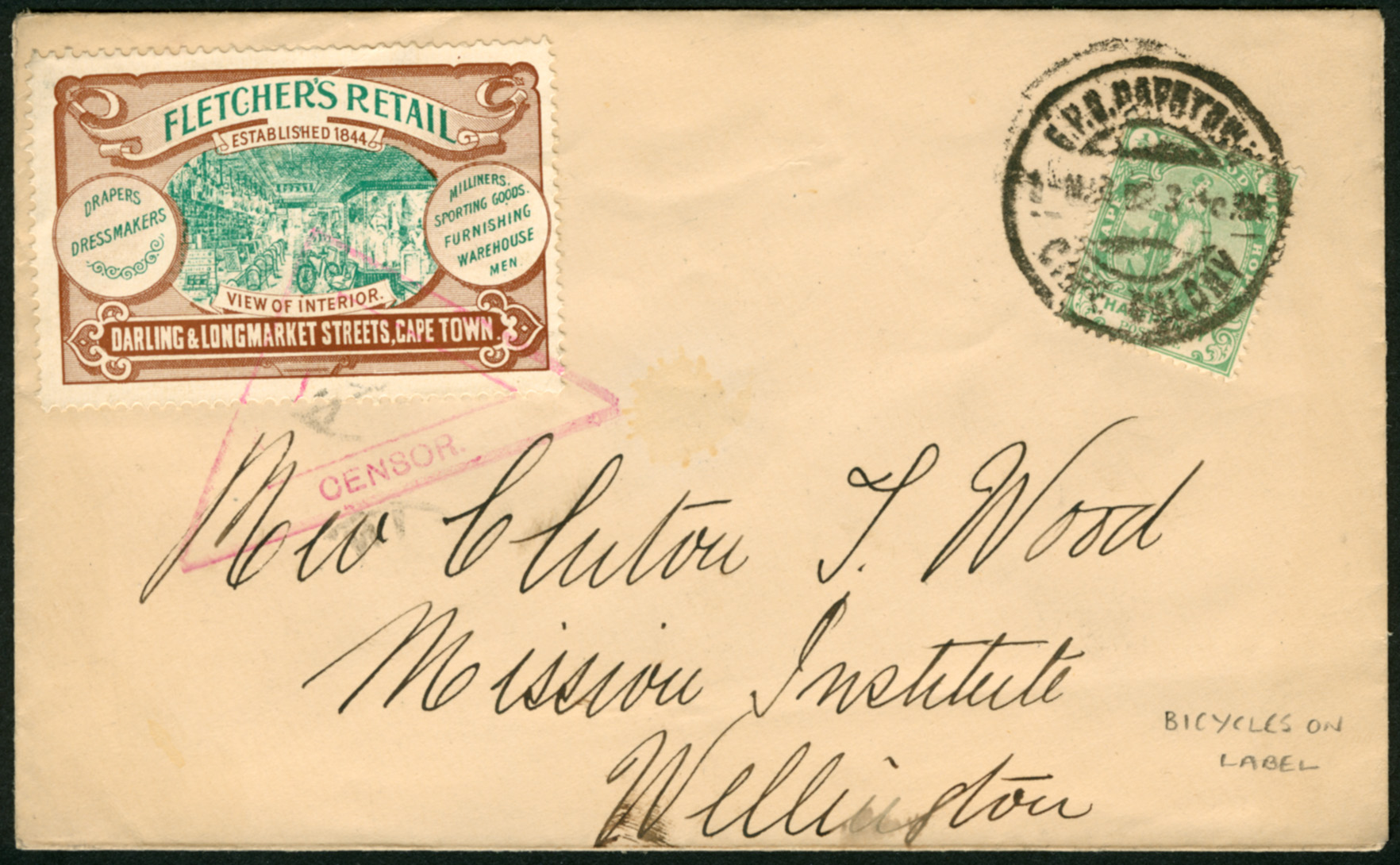
1902. Censored Letter. CAPE TOWN 'MR 03 02' to WELLINGTON 'MR 3 1902'.
Fletcher's Retail label tied to cover with Triangular Censor mark.
Fletcher's Retail is presumably part of Fletcher's & Cartwright, a major Cape Town department store.
Little is known of the addressee, the Rev. Clinton Tyler wood, a missionary running the Young Men's Institute, Wellington, Cape. He contributed an article, "A GREAT OPPORTUNITY IN SOUTH AFRICA" to an American missionary publication. The article is liberal and apparently fair to the Boer Christians. It appears that he came late to missionary work. The Rev. Wood died Jan. 26, 1932

